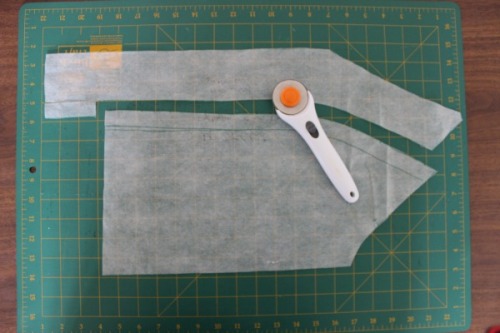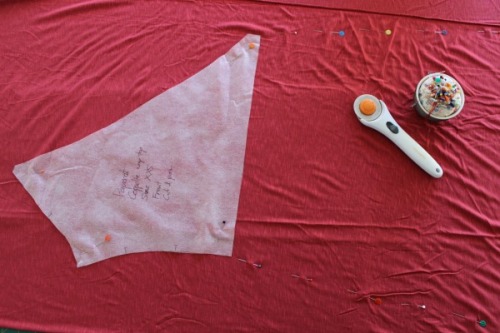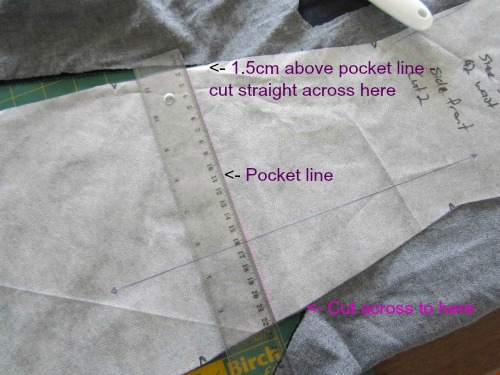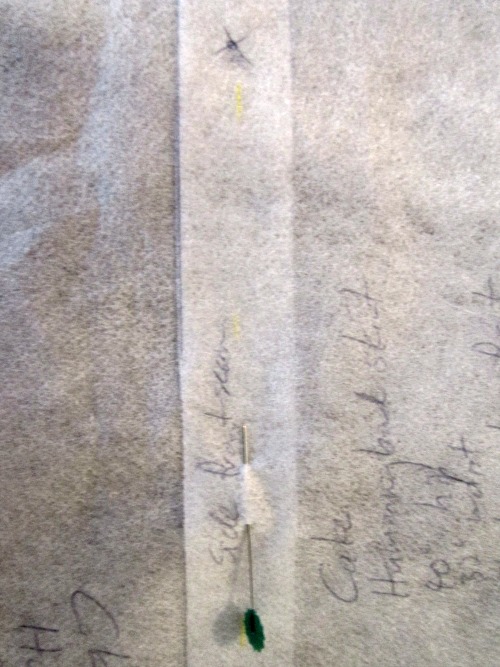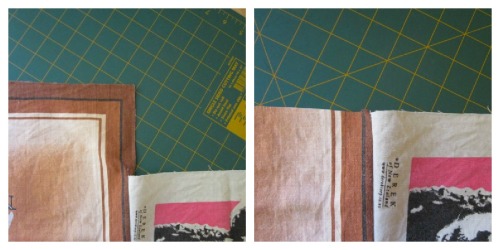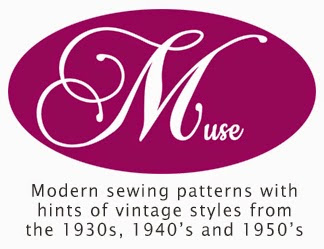My current project (well, my just-completed-but-no-photos-yet project, really) is the Rigel bomber jacket by Papercut Patterns. I made one key change to the pattern while sewing it up – I added a lining. Which, from looking around the blog-o-sphere, is something that quite a few people have done, or want to do. So, in case it’s useful for anyone else, here’s how I lined my Rigel bomber jacket….
Now, usually linings in jackets have more ease than the jacket itself – if you look at any tailored, lined RTW jacket you’ll usually see it has a small pleat at the centre back just below the neckline facing, and the lining is also longer at the hem and sleeve cuffs and bags out slightly. Since the Rigel bomber is a loose-fitting style (and since I wanted to do a quilted lining for my jacket) I haven’t added any of that extra ease – instead, the lining pieces I made were directly from the main jacket pieces. (It’s pretty easy to add the extra ease if you want it though – simply make your lining pieces longer, and add a small extension at the top of the centre back seam of the lining.) So with that in mind, let’s get started!
Cutting the lining
Three new pattern pieces need to be made for the lining – front, back and sleeves. Start by tracing the original front, back, and sleeve pieces. (Note: use variation 1 sleeve as a base for the lining, no matter which variation you’re making.) Remember to mark on all three pieces that they’re for the lining!
Front lining
Trace the facing pattern piece onto your front lining piece, lining up the edg of the facing with the edg of th front lining, and making sure . (It’ll be the same width as the front extension.)
Add 2cm seam allowance from the line you just traced, towards the centre front seam. (Why 2cm? Because the original facing piece doesn’t have seam allowance on the open edge. Since we’re now going to be attaching another piece to it, we need to allow for seam allowance for both sides of that new seam. It’s easier to add it to the new lining piece rather than mucking around with two pattern pieces.)
Cut along your new line – the larger piece is now your front lining. Yay! (You won’t need any lining on the front extension of the jacket as the facing will take care of that part, so just cut straight across from the bottom of the lining piece to the new line you made.)
Back lining
Trace the facing pattern piece onto your back lining, with the neck edges aligned. The curved end of the facing is the one that lines up along the back, as this will follow the curve of your neck. The facing has a centre back seam and the back lining won’t, so we’ll need to adjust for this – simply let the facing piece overhang at the centre back by 1cm.
(Note: if you’re wanting to incorporate an ease pleat in your lining (that little pleat you see in the lining of most fitting jackets near the back neckline) this is when to do it. Once you’ve got your back lining traced out, simply extend the back neckline of the lining by 1cm at the centre back and connect the new point to the bottom of the centre back with a straight line. Remember to mark where the ease is, so when you sew it up you can create a small pleat there.)
Add 2cm seam allowance towards the outside edge.
Cut along your new line.
Sleeve lining
Rather than messing around with figuring out which part of the facing to trace onto the sleeve, we’re simply going to measure it. The facing is 8.5cm wide. So, to allow for the 2cm seam allowance that needs to be added, measure down 6.5cm from the upper edge of the sleeve, and draw a line that follows the curve of the sleeve.
Cut along your new line.
Sewing the lining
Cut out and stitch the lining pieces together the same as you would for the jacket shell – attach the sleeves to the front lining pieces, and also to the back lining piece.
Attaching the facing to the lining
Pin the centre back seam of the facing to the centre back of the back lining, right sides together. The facing will be curving downwards.
Pin the rest of the facing to the lining. Make sure the distance from the end of the lining to the end of the facing is the same as the front extension, i.e. 7cm. You’ll need to ease the facing onto the lining, due to the difference in curvature at the edges.
Press the seam towards the facing.
Your lining is now finished, and ready to be sewn into your jacket shell.
(Note: the fabric at the end of the sleeves of my lining is the same as my facing, because of a late pattern adjustment to lengthen the sleeves. Just in case you’re wondering why the lining fabric doesn’t extend right to the end of the sleeves in these and the following photos. I has long gorilla arms. :-p )
Sewing the jacket shell
Stitch up the jacket shell as per the instructions, with the following changes:
- when attaching the bottom ribbing, stitch the short end onto the front extension with a 1cm seam allowance, rather than folding the front extension under and topstitching to attach the ribbing
- don’t topstitch around the bottom ribbing (or you’ll have trouble attaching the lining!). Instead, press the seams of the ribbing towards the jacket body
- when you get to the instructions for attaching the facing, skip over these and go and attach the sleeve cuffs instead
Sewing in the lining
Attaching the lining to the jacket body
Pin the lining onto he jacket as per the instructions for attaching the facing, and continue pinning all the way along the bottom of the jacket as well. Make sure the bottom ribbing is folded inside, just like the neck ribbing is, so it doesn’t get caught in the stitching).
Sew the lining to the jacket, leaving a 10cm gap for turning the jacket back around the right way (I left my turning gap at the bottom of the jacket). Tip: When stitching, have the shell fabric on the top, so that you can follow the stitching lines for the zip and ribbing to get the lining perfectly aligned on the inside with no stitching showing.
The tricky bit will be the corners of the ribbing along the bottom of the jacket – follow the line of stitching that you made when attaching the ribbing to the jacket shell, and pivot at the corners. Clip the lining to the stitching at the corner (just as you did with the jacket shell at the same point) so it sits flat.
Turn your jacket the right way around, through the gap you left when attaching the lining. Poke out the corners at the bottom of the front extension so they’re nice and sharp, and give them a good press.
Attaching the lining to the sleeves
First, try your jacket on to make sure your lining isn’t twisted inside the sleeves. The lining should be sitting nicely inside the sleeves, with the seams of both lining and shell aligned.
Fold a small section of the seam allowance of the lining under and pin it to the shell, mimicing how it will look when it’s sewn. (Note: this pin is to make sure the lining and the shell don’t get twisted while we’re stitching the sleeve lining on, so you only need to pin a small section. One pin will be enough.) It’s a good idea to pin at or next to the seams, to make sure the lining doesn’t get twisted in the next steps. They
Reach inside the jacket through the gap you left when attaching the lining to the shell, and pull the sleeve out through the gap. The sleeve and the sleeve lining will now be next to each other, attached by the small section you just pinned.
Pinch the pinned section together so it doesn’t move, take out the pin, and repin it with right sides together and raw edges aligned so you can stitch them together.
Tuck the cuff down inside the seam so it doesn’t get caught in the stitching, and pin the sleeve and the sleeve lining together all the way around with the raw edges aligned and right sides together.
Stitch together. (Tip: stitch with the shell on top, so you can follow the line of stitching you made when you attached the cuff.)
Pull the sleeve back through to the right side of the jacket – it’ll now be all nicely lined! 🙂
Repeat the process with the second sleeve.
Finishing
Slipstitch the gap in the lining closed, give it all a good press, and you’re done! Yay! 🙂






